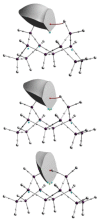Interacting Quantum Atoms-A Review
- PMID: 32899346
- PMCID: PMC7504790
- DOI: 10.3390/molecules25174028
Interacting Quantum Atoms-A Review
Abstract
The aim of this review is threefold. On the one hand, we intend it to serve as a gentle introduction to the Interacting Quantum Atoms (IQA) methodology for those unfamiliar with it. Second, we expect it to act as an up-to-date reference of recent developments related to IQA. Finally, we want it to highlight a non-exhaustive, yet representative set of showcase examples about how to use IQA to shed light in different chemical problems. To accomplish this, we start by providing a brief context to justify the development of IQA as a real space alternative to other existent energy partition schemes of the non-relativistic energy of molecules. We then introduce a self-contained algebraic derivation of the methodological IQA ecosystem as well as an overview of how these formulations vary with the level of theory employed to obtain the molecular wavefunction upon which the IQA procedure relies. Finally, we review the several applications of IQA as examined by different research groups worldwide to investigate a wide variety of chemical problems.
Keywords: IQA; bonding analysis; energy partition.
Conflict of interest statement
The authors declare no conflict of interest.
Figures







Similar articles
-
Energetics of Electron Pairs in Electrophilic Aromatic Substitutions.Molecules. 2021 Jan 19;26(2):513. doi: 10.3390/molecules26020513. Molecules. 2021. PMID: 33478091 Free PMC article.
-
Merging the Energy Decomposition Analysis with the Interacting Quantum Atoms Approach.J Chem Theory Comput. 2023 Jun 27;19(12):3469-3485. doi: 10.1021/acs.jctc.3c00143. Epub 2023 May 29. J Chem Theory Comput. 2023. PMID: 37246911 Free PMC article.
-
Physical nature of interactions in Zn(II) complexes with 2,2'-bipyridyl: quantum theory of atoms in molecules (QTAIM), interacting quantum atoms (IQA), noncovalent interactions (NCI), and extended transition state coupled with natural orbitals for chemical valence (ETS-NOCV) comparative studies.J Phys Chem A. 2014 Jan 23;118(3):623-37. doi: 10.1021/jp410744x. Epub 2014 Jan 9. J Phys Chem A. 2014. PMID: 24377828
-
Atoms in molecules in real space: a fertile field for chemical bonding.Phys Chem Chem Phys. 2023 Apr 12;25(15):10231-10262. doi: 10.1039/d2cp05540f. Phys Chem Chem Phys. 2023. PMID: 36994471 Review.
-
Multiscale molecular modelling: from electronic structure to dynamics of nanosystems and beyond.Phys Chem Chem Phys. 2022 Apr 20;24(16):9051-9081. doi: 10.1039/d1cp05928a. Phys Chem Chem Phys. 2022. PMID: 35389399 Review.
Cited by
-
The IQA Energy Partition in a Drug Design Setting: A Hepatitis C Virus RNA-Dependent RNA Polymerase (NS5B) Case Study.Pharmaceuticals (Basel). 2022 Oct 8;15(10):1237. doi: 10.3390/ph15101237. Pharmaceuticals (Basel). 2022. PMID: 36297349 Free PMC article.
-
Nature of Beryllium, Magnesium, and Zinc Bonds in Carbene⋯MX2 (M = Be, Mg, Zn; X = H, Br) Dimers Revealed by the IQA, ETS-NOCV and LED Methods.Int J Mol Sci. 2022 Nov 24;23(23):14668. doi: 10.3390/ijms232314668. Int J Mol Sci. 2022. PMID: 36498996 Free PMC article.
-
Molecular Tailoring Approach for the Estimation of Intramolecular Hydrogen Bond Energy.Molecules. 2021 May 14;26(10):2928. doi: 10.3390/molecules26102928. Molecules. 2021. PMID: 34069140 Free PMC article. Review.
-
Non-covalent interactions from a Quantum Chemical Topology perspective.J Mol Model. 2022 Aug 25;28(9):276. doi: 10.1007/s00894-022-05188-7. J Mol Model. 2022. PMID: 36006513 Free PMC article.
-
Energetics of Electron Pairs in Electrophilic Aromatic Substitutions.Molecules. 2021 Jan 19;26(2):513. doi: 10.3390/molecules26020513. Molecules. 2021. PMID: 33478091 Free PMC article.
References
-
- Hayes I., Stone A. An intermolecular perturbation theory for the region of moderate overlap. Mol. Phys. 1984;53:83–105. doi: 10.1080/00268978400102151. - DOI
-
- Jeziorski B., Moszynski R., Szalewicz K. Perturbation Theory Approach to Intermolecular Potential Energy Surfaces of van der Waals Complexes. Chem. Rev. 1994;94:1887–1930. doi: 10.1021/cr00031a008. - DOI
-
- Stone A.J. The Theory of Intermolecular Forces. Oxford University Press; Oxford, UK: 2013.
-
- Hobza P., Muller-Dethlefs K. Non-Covalent Interactions. Royal Society of Chemistry; London, UK: 2009. - DOI
-
- Boys S., Bernardi F. The calculation of small molecular interactions by the differences of separate total energies. Some procedures with reduced errors. Mol. Phys. 1970;19:553–566. doi: 10.1080/00268977000101561. - DOI
Publication types
MeSH terms
Grants and funding
LinkOut - more resources
Full Text Sources

